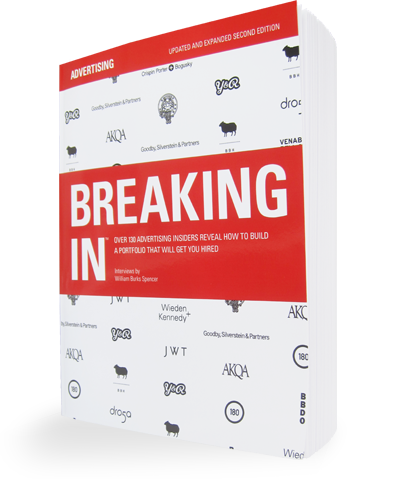In case you missed it, check out some great work from Dave Bell.
WS: What do you look for in a student book? And what impresses you?
DB: Whenever we’ve hired people, it’s always—and it’s probably a cliché—but it’s always the things they bring alongside the book. So sometimes, for example, we hired a young Scottish writer here a year ago, I think. I had seen his portfolio. He sent a PDF and there were all these odd mock-ups he made in London, and [for] another agency here. There were ads, and they were quite nice but it wasn’t really showing any of his personality. And then he came again. I read his portfolio, then we chatted, and it was the same work—another couple of odd campaigns he made, produced while working his first job—and then he had a little bag with him. He was too shy to take it out, and he was probably thinking, “I don’t have enough time.” So I asked what was in there. He showed me, it was filled with his writing and it was great. I mean it was laugh-out-loud funny and he made his own illustrations which were good—really nice quality and very expressive and they told a lot more than the ads. We hired him on that basis. It’s good to know that you can make an ad, but in the end we always hire people based on their free work.
The other thing we hire them on is just their personality. I mean, there’s 35 people here and you’re on top of each other all the time. There are no departments, so you kind of overlap with everyone and you can get in each other’s way, so you have to be a pretty nice person to be able to deal with that without turning into an asshole.
And I remember Johan and Erik, the founders [Johan Kramer and Erik Kessels]. They hired creatives here and they didn’t see their book at all. I think they hired one creative because he was a nice guy and he used to play professional football and they’re both really big football fans. They knew there was a connection and he turned out to be a really, really good writer. So I think for us these are the two things. The second one you can’t get by email.
[ … ]
WS: For writers, do you want to see copy?
DB: Yeah, for sure. But I don’t know the last time I really wrote a piece of copy in an ad. I’d like to see that for sure, if it’s very quick, of course. The way it is here, as I said, things overlap. The writers do a lot of the strategy, and strategy helps the writer, and the two work very closely together. So you end up writing a presentation with strategies. So you need to be able to write…I’d rather see a good presentation than a funny piece of advertising copy or I’d rather see a short story.
We hired a writer from Kentucky here. He had a book and a website called “Very, very short stories.” I think they were about three lines long but he had hundreds of them, and you could flip through them and see how good a writer he is with these stories. But for a writer, design skills are not necessary. There’s much more multidiscipline students now than when I was a student. There were no computers, which was not so long ago but it feels like a long time ago in terms of where students are now. When I went to college it was just, “You’re a writer, you are an art director, you’re a designer.” It was much more separate. Now it’s a bit mixed up, I think. I hope.

Comments are closed.